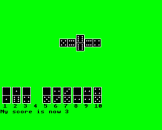Introduction
Dominoes in one form or another is played in most countries of the world and was probably invented by the Chinese and reached Europe in the fourteenth century. In these computerised versions of the basic game and variations, you will play against the computer. Clear graphics and checking of invalid moves makes the games thoroughly enjoyable to play.
Traditional Dominoes
This version of dominoes uses 28 pieces with numbers from zero to six.
You and the computer will each be given the same number of pieces, between 6 and 14. If neither has the double size dealing continues until someone receives it. Play then starts with the double six which the computer will move.
When it is your turn to play, if you can move, you choose one of your pieces which matches one of the free ends of the row; e.g. if the ends are 3 and 5, you can move any of your pieces which has a 3 or a 5. If you have no such piece, enter P for Pass.
The game ends when neither player can move or when one player has no dominoes. The winner is the player with the smallest total number of dots.
Threes And Fives
This game is played exactly the same as dominoes, but the scoring is different.
Each time you put a piece in place, the number of dots on the ends of the row of dominoes is totalled. This total is then divided by three and then by five and if either goes exactly, your score increases by the quotient.
For example: if the ends of the row are 5 and 4, the total is 9 (5+4); since 3 divides into 9 three times, your score increases by 3.
The winner is the player who finishes with most points.
Disputing Tens
Disputing Tens is a version of an old game which uses the set of Chinese dominoes. There are no blanks, and some of the pieces are duplicated.
You and the computer are each dealt sixteen dominoes face downwards; yours is the lower set on the screen. One is turned over and may be put on the right of the row.
However, if it makes a pair or a ten, it is removed and the sum of the dots on the dominoes taken away is added to your total.
You have a pair if the domino you have just turned over is the same as one at either end of the row. Both are removed.
You have a ten if three dominoes are exactly divisible by ten.
These three dominoes are the one just turned and
- the two at the right hand end of the row, or
- the two at the left hand end of the row, or
- the last on the left and the last on the right.
If either of you miss a pair or a ten, the other may take it.
The game ends when one player has no dominoes left.




